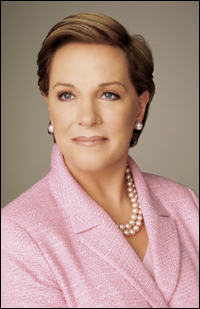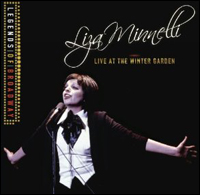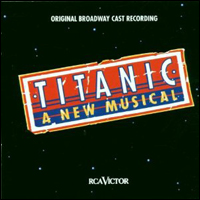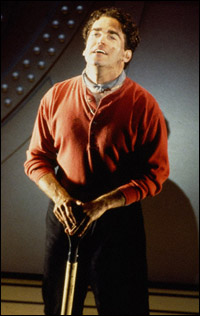
*
Julie Andrews/Carol Burnett: The CBS Television Specials [Masterworks Broadway]
Put a couple of show business legends onstage before a New York audience, with a full orchestra, and televise it as a special. That was the case with two CBS evenings now released, together as "Julie Andrews/Carol Burnett: The CBS Television Specials." Legendary ladies with an asterisk, I suppose; an asterisk which makes the earlier portion markedly more interesting and intriguing than the second.
The April 29, 1962 "Julie and Carol at Carnegie Hall" has gone down in legend, practically. (The concert was telecast on June 11.) Julie and Carol were poised, both, on the threshold of undreamed of and perhaps unexpected fame; certainly, no one had any idea they would each soon be in a league —more or less — with Elizabeth Taylor. Julie had by this point starred in My Fair Lady (in New York and London) and Camelot, making her the toast of Broadway. That said, "Julie and Carol at Carnegie Hall" was a television special — and television-wise, Julie was just another Broadway singer (albeit a major one).
Carol, too, had enjoyed Broadway stardom in Once upon a Mattress; but that was fleeting and by 1962 forgotten. (Mattress opened at the Alvin in November 1959 and lasted seven months; it wasn't until 1964 — by which point Burnett was becoming a major TV personality — that Mattress was first telecast.) In 1962, though, Carol was more famous than Julie, at least with TV audiences; she had appeared in three dozen episodes of "The Garry Moore Show," winning herself an Emmy for Outstanding Performance in a Variety Program just prior to "Julie and Carol at Carnegie Hall." For which she won another Emmy, the second year in a row.
The Carnegie Hall special was an offshoot of "Garry Moore"; Julie appeared on four episodes during the 1961-62 season, and the chemistry with Burnett was immediately apparent. So immediate that "Moore" producer (Bob Banner) and director (Joe Hamilton) sold CBS on doing the special. But "Julie and Carol at Carnegie Hall" in 1962 was something of a dark horse to audiences in general; we can imagine, though, just how good this special seemed at the time.
| |
 |
|
| Julie Andrews |
That could be said for much of the second disc; it does seem like just another weekly installment of Carol's weekly show, with Julie Andrews as special guest. (Part of what the material on the first disc has that the second doesn't is the sharpness of Mike Nichols; Carol's TV team — headed by Ken and Mitzi Welch — wrote the second show. Which was produced by Hamilton, who by then was married to Burnett.)
Read more about Carol Burnett's Broadway career in the Playbill Vault.
Also missing on the second special is the presence of musical director/arranger/orchestrator Irv Kostal, who served as the musical common denominator between the stars. Kostal had helped sculpt the sound of Burnett over the Gary Moore years, as well as for the 1961 solo LP "Carol Burnett Remembers How They Stopped the Show." He went back even further with Andrews, as conductor/arranger of her 1957 and 1958 solo albums. (He would continue working with Andrews after the Carnegie Hall show, on "Mary Poppins" and "The Sound of Music.")
The first special includes an extended parody of The Sound of Music called "The Pratt Family," this from the time before Andrews was hired to play Maria. (Having just been passed over for the film adaptation of My Fair Lady, the pre-Poppins Andrews must have seemed a longshot for The Sound of Music.) The song corresponding to "Do-Re-Mi" is here entitled "Ding Dong Yum Yum Yum," which gives you an idea of the artfulness of the piece. The song is credited to Welch and Nichols, who must have been happy to leave lyric-writing behind. Even so, I imagine it was much funnier watching Julie and Carol do this sketch than it is to simply hear it.
The showpiece of the 1962 act is a nine-minute "History of Musical Comedy." This is a super-medley, presumably devised by Kostal, incorporating 25 show tunes — sometimes sung in counterpoint — ranging from Victor Herbert on. Andrews is perfect with this sort of material, while Burnett pretty much munches on the lyrics in hilarious manner. (Did this sketch, by itself, win her that Emmy?) The thing builds to "A Boy Like That," with Carol singing Anita in a manner that is well-nigh indescribable. Just when you are bursting with laughter, they move into Julie's glorious "I Have a Love." From absurd to glorious in a few bars, the medley is quite something.
The 1971 concert attempts to recreate the magic with a 14-minute "Medley of the 60s," incorporating 47 songs from the Beatles on. This sounds like a couple of upper crust establishment superstars trying hard to sound groovy, with Peter Matz at the podium. All of which is to say that "Julie Andrews/Carol Burnett: The CBS Television Specials" is at once delightful and somewhat manufactured. But the Carnegie Hall half — which ends with a hokey version of Frank Loesser's "Big D" — is highly entertaining.
Read more about Julie Andrews' Broadway career in the Playbill Vault.
Visit PlaybillStore.com to view theatre-related recordings for sale.
| |
 |
|
| Cover art |
"Liza Minnelli Live at the Winter Garden" is — well, Liza Minnelli live at the Winter Garden.
The show itself, which opened Jan. 6, 1974, for a limited engagement of 23 performances, was a smash hit sellout; the 27-year-old Liza was at the height of her fame and, perhaps, talent. (The show, in the theatre, was simply titled Liza.)
This is quite an act, written by (of course) Fred Ebb and directed by (of course) Bob Fosse. And it is recorded live, with an audience of fans at least some of whom seem overwhelmed. But it is very 1974, if you will; all those pop music flourishes sound — well, 1974. (I didn't much like this sound then, either.)
Conversely, there are a few prizes hidden away. Two very Kander & Ebbish pieces of special material, "Exactly Like You" and "I'm One of the Smart Ones." Both of them are bright, smart and brash; this concert came just around the time that the boys were writing Chicago with Fosse. The latter song has an arresting comedy orchestration by Jonathan Tunick. Minnelli also sings two dramatic and very good Charles Aznavour songs, "And I in My Chair" and "There Is a Time." (Ebb provided the translation for the first, as well as a Piaf song included in the show.) There are also three bonus tracks which did not appear on the 1974 LP release, including a tender "My Shining Hour" which mixes in K&E's then-recent showtune, "Yes."
Yes, Liza sings up a storm, live at the Winter Garden. Somehow, though, much of it leaves me kind of cold.
Read more about Liza Minnelli's Broadway career in the Playbill Vault.
Visit PlaybillStore.com to view theatre-related recordings for sale.
| |
 |
|
| Cover art |
At any rate, I have celebrated the occasion by pulling out the original cast album of Maury Yeston's Titanic [RCA Victor 09026-68834]. It is a score that I admire and think highly of, but rarely feel compelled to revisit. Something about it seems weighty — not unlike the musical itself — in a manner that makes me less than eager to push the play button. It's almost as if I need to prepare myself to pay close attention, which rules out putting it on just for fun.
With the Titanic anniversary at hand — and with the prodding of my editor — I have duly listened to it thrice over the last day. Once as a refresher, once analytically, and once just playing through the tracks I like best. Yes, this is a score to admire. Yeston seems to have built his score on a grand scale, just as the Titanic itself was built. The opening sequence — incorporating "How Did They Build Titanic?" and "I Must Get on That Ship" — remains astounding. It is presented on the recording in a 16-minute stretch, spread across six tracks; at once bounteous, majestic and intriguing.
Does the recording live up to the opening? Did the show itself live up to it? Not quite was my opinion back in 1997, when I saw it just before and just after the opening, and so it remains. I expect that the problem derived from the overstocking of characters in the book by Peter Stone. This sort of thing works sufficiently well in a disaster movie, where you have two dozen or so faded movie stars each with a scene or two. What happened in Titanic at the Lunt, for me, was that I was instantly and earnestly involved with some of the characters: the Second Class lady created with comic flair by Victoria Clark, Brian d'Arcy James as the earnest stoker with the voice, the three Irish lasses named Kate. But I was not quite so interested in too many of the others. As the boat hit an iceberg and started to slide into the sea, I was all the more concerned with the fate of the characters I cared about — but impatient when the authors insisted on spending time with the rest.
| |
 |
|
| Brian d'Arcy James in Titanic. | ||
| photo by Joan Marcus |
If Titanic is languishing on your shelf, this is an apt time to refresh your acquaintance. If you don't know Titanic — and you have any interest in full-scale, dramatic Broadway musicals with soaring scores — you might want to take a maiden voyage. In a manner of speaking.
Read more about the Broadway history of Titanic in the Playbill Vault.
Visit PlaybillStore.com to view theatre-related recordings for sale.
(Steven Suskin is author of the recently released updated and expanded Fourth Edition of "Show Tunes" as well as "The Sound of Broadway Music: A Book of Orchestrators and Orchestrations" (now available in paperback), "Second Act Trouble" and the "Opening Night on Broadway" books. He also pens Playbill.com's Book Shelf and DVD Shelf columns. He can be reached at [email protected].)










